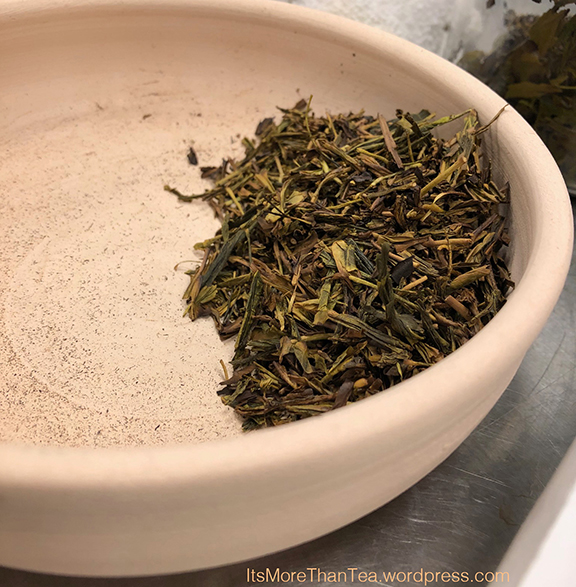Mr. Takatomo Katagi comes from a long line of tea growers in Japan’s Asamiya region of the Shiga Prefecture.

The seventh-generation head of Katagi Kokaen tea garden, Mr. Katagi is building on his family’s legacy.
Some forty years ago, his father converted the garden to organic production. As Mr. Katagi explains, “Unlike vegetables, tea leaves will never undergo washing before packaging. . . . so we made the move to stop using all chemical fertilizer and pesticides.”*
Despite an initial three years of loss, the family remained firmly committed to organic methods—and the plants finally recovered and adjusted. Spiders, praying mantises, and birds, Mr. Katagi notes, help keep the pests in check.
The garden’s location is also conducive to growing tea, he told us at a March 2 wagashi-making and tea-roasting workshop at TeaHaus in Ann Arbor, Michigan.

Situated on slopes 1300–1600 feet in elevation, the drastic temperature change from day to night generates fog that protects the tea.
The slopes also mean that the tea cannot be harvested with large equipment. Rather, the leaves either are hand plucked—the average age of these highly skilled workers is 70 years old—or are harvested using very small machines.



The tea produced from hand-plucked leaves is used for tea competitions.
For example, the very dark green, lustrous, long, folded leaves of Mr. Katagi’s Handpicked Kabusecha have an intoxicating aroma and an incredible flavor! Only small amounts of such premium teas are produced each year.

For kabusecha, the plants are covered for a few days to two weeks before harvest (kabuse means “cover”). The reduced sunlight stresses the plants so that they produce more chlorophyll and the amino acid L-theanine.
In sunlight, L-theanine converts to catechins, which impart an astringent or bitter flavor to the leaves. When you prevent that reaction from taking place, the theanine is retained as theanine—giving the tea leaves a lot of umami, more sweetness, and little astringency.
Light-strapped leaves produce more chlorophyll to maintain their energy requirements. Higher levels of chlorophyll also mean the leaves have more color so as a result, kabusecha tea leaves are a deep and vibrant green color—the darker the green, the higher the quality.
Teas such as this kabusecha are sold as Asamiya tea, a single origin tea. Of all the Asamiya green tea produced each year, around 250,000 tons, only 10% of it is sold as Asamiya tea; the rest is sold as Uji tea, which is a blend of tea from four prefectures.
Mr. Katagi also demonstrated how he makes Houjicha (or Hojicha), “roasted tea” (also see an earlier post, What is Japanese Hojicha?), using a handmade pottery pan. Called Shigaraki or Shigarakiyaki, this stoneware is made in Shiga and is known for its earthy colors and rough surface.
The handle of this pan is actually hollow and the pan itself is extremely lightweight. It’s designed so that it heats evenly, including the sides, which allows the tea leaves to fluff as they roast.
Mr. Katagi pours a small amount of Aracha, raw unrefined tea leaves, into this pan and roasts them over a gas flame. This is a quick process, and he often holds the pan several inches above the flame while shaking the pan. You can actually see the leaves move and fluff up as they start turning brown.






The tea is simply amazing! I love its strong flavor—toasty and nutty and warm. Houjicha is a unique tea, and freshly roasted houjicha is even better! Despite the roasting process, houjicha is still classified as a green tea, and the brewed leaves shown above certainly attest to that!
Mr. Katagi also produces Deep Roasted Houjicha, with dark chocolate-colored leaves and a strong roasted aroma. Unlike the lightly roasted leaves that he demonstrated at our workshop, these leaves and stalks have been more heavily roasted.

I really enjoyed this evening with Mr. Katagi. Besides learning more about his tea garden, watching a tea master deftly roast leaves and then immediately tasting his tea was a terrific experience!
Handpicked Kabusecha and Deep Roasted Houjicha are currently available in limited quantities at TeaHaus. Be sure to check out the short videos as well!
*Cool Shiga, vol. 5, Shiga Prefecture, October 2019.

Finally got around reading this post and I am absolutely fascinated with it. I’ve already had a large interest in tea and all related to it and it seems your blog will feed my hunger for tea knowledge!
But seriously, average age of 70??
LikeLike
Yes—there is no exaggeration on the age! And thanks for your interest!
LikeLike